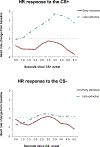Examining the cardiovascular response to fear extinction in a trauma-exposed sample
- PMID: 32126364
- PMCID: PMC7097830
- DOI: 10.1016/j.jpsychires.2020.02.024
Examining the cardiovascular response to fear extinction in a trauma-exposed sample
Abstract
Background: Trauma and symptoms of posttraumatic stress disorder (PTSD) have repeatedly been linked to impaired cardiovascular functioning. Poor fear extinction is a well-established biomarker of PTSD that may provide insight into mechanisms underlying cardiovascular risk. The current study probed the cardiovascular response to extinction in a sample of trauma-exposed individuals.
Methods: Participants were 51 trauma-exposed women who underwent a fear conditioning paradigm. Heart rate (HR) during extinction was examined in response to a conditioned stimulus that was previously paired with an aversive unconditioned stimulus (CS+) and one that was never paired (CS-). Heart rate variability (HRV) was calculated at baseline and during the extinction session.
Results: Consistent with fear bradycardia, initial HR deceleration (.5-2s) after CS + onset occurred during early extinction and appeared to extinguish over time. Higher baseline HRV was significantly associated with greater fear bradycardia during early extinction.
Conclusions: This is the first study to demonstrate a pattern of fear bradycardia in early extinction, which was associated with higher HRV levels and decreased over the course of the extinction phase. These results suggest that increased fear bradycardia may be indicative of greater vagal control (i.e., HRV), both of which are psychophysiological biomarkers that may influence cardiovascular and autonomic disease risk in trauma-exposed individuals.
Keywords: Cardiovascular; Extinction; Fear bradycardia; Heart rate; Trauma.
Copyright © 2020 Elsevier Ltd. All rights reserved.
Figures



References
-
- American Psychiatric Association, 2013. Diagnostic and Statistical Manual of Mental Disorders, fifth ed. American Psychiatric Publishing, Virginia.
-
- Baek HJ, Cho CH, Cho J, Woo JM, 2015. Reliability of ultra-short-term analysis as a surrogate of standard 5-min analysis of heart rate variability. Telemed. J. E. Health 21, 404–14. - PubMed
-
- Binder EB, Bradley RG, Liu W, Epstein MP, Deveau TC, Mercer KB, Tang Y, Gillespie CF, Heim CM, Nemeroff CB, Schwartz AC, Cubells JF, Ressler KJ, 2008. Association of FKBP5 polymorphisms and childhood abuse with risk of posttraumatic stress disorder symptoms in adults. JAMA 299, 1291–1305. 10.1001/jama.299.11.1291 - DOI - PMC - PubMed
Publication types
MeSH terms
Grants and funding
LinkOut - more resources
Full Text Sources
Medical

